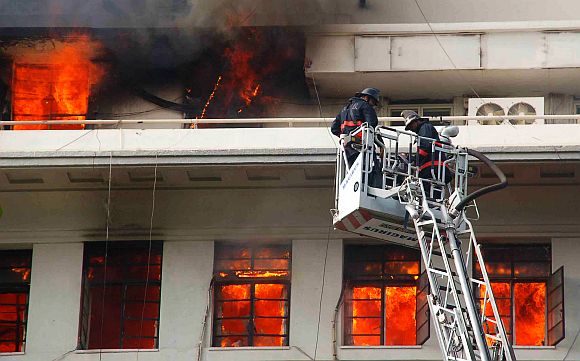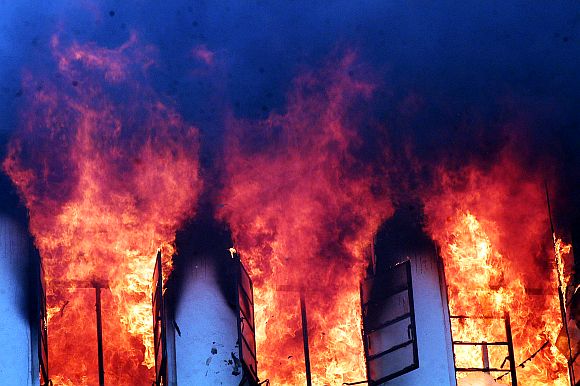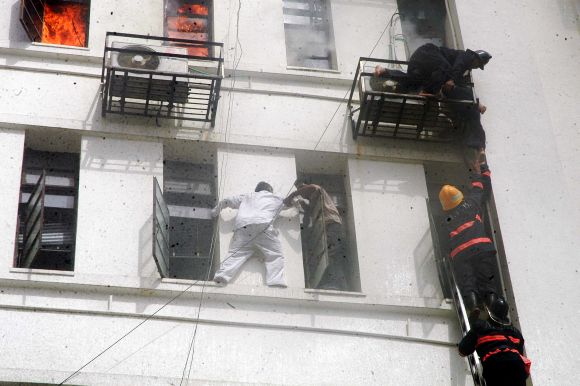
The Mantralaya inferno and how it played out, from inside the building, on the street, and in the blame game afterwards, elaborates Sanjay Jog.
For the chief minister's public relations officer Satish Lalit, Thursday, June 21, was like any other day. He was preparing speeches for his boss Prithviraj Chavan, compiling press clippings and dealing with journalists in his office on the sixth floor of Mantralaya. This famous but humdrum-looking building, in Nariman Point and with 5 lakh sq ft of floor space, houses many departments of the state government.
Lalit and some colleagues had just gathered in Deputy Chief Minister Ajit Pawar's committee room on the sixth floor gangway, for a meeting on wages and allowances. At around 3 pm, however, a constable knocked on the door and told the group that a fire had broken out on the fourth floor and was spreading. He asked them to leave the building.
What happened later was seen and experienced by over 6,000 people in the building at the time, including some 2,500 government employees. They faced thick smoke, huge flames and the deafening sound of glass shattering and cylinders bursting.
Please ...

Those inside the building sought every possible escape route, including water pipes down the facade, windows and staircases. A host of ministers, including Pawar, former chief minister Narayan Rane, rural development minister Jayant Patil and tribal development minister Babanrao Pachpute, literally forced employees and their visitors to come out of Mantralaya's cosy rooms and grand cabins.
By this time, fire-fighters with fire tenders, hydraulic platforms and turntable ladders had arrived in the compound. They rushed into the building and took charge.
A "brigade call" was sent out, which calls in all available fire tenders -- even those deployed as reserve at other locations and those from public and private sector undertakings. The fire-fighters rescued panicked people stranded on parapets and terraces.

The fire was spreading fast. Chief Minister Chavan, his ministerial colleagues, the chief secretary and other bureaucrats were supervising, but were helpless to prevent the fourth, fifth and sixth floors being gutted by the fire.
All six elevators in the main building and the annexe were shut down. People were made to leave from the three main entrances. Cars parked outside were removed to make room for the fire-fighters. Roads were cordoned off.
Many Mumbaikars were leaving for home after work. Local residents were about to go for their daily evening walk. What road space there was had been captured by TV vans and journalists.
Some passersby asked each other for news, others photographed or filmed the burning Mantralaya with their mobile phone cameras.

Two navy helicopters buzzed overhead, but were asked to leave. The fire personnel worried that as the evening breeze from the Arabian Sea picked up, it would fan the fire.
At one point there seemed to be no sign of the fire coming under control. TV news channels were flooded by reports suggesting conspiracy or arson.
Crucial files relating to several scams (so the talk went) -- including the Adarsh building, Lavasa township and the allocation of plots in Pune and other places -- were stored in the urban development department in particular.
People on the streets openly wondered whether the fire was deliberate and not due to a short-circuit, as announced by the state relief and rehabilitation minister Patangrao Kadam at 3.30 pm.

As a result, the Central Bureau of Investigation had to officially clarify that all files pertaining to Adarsh scam were in safe custody.
Chavan himself declared at the crowded press conference that there was no sign of sabotage and that he had ordered a probe by the Criminal Investigation Department.
He added that 2.17 lakh government files and 3.28 crore pages had been electronically scanned and that the government would take the help of Nasscom and the KPMG cyber cell, and even of foreign experts, to recover any data from computer hard disks damaged in the fire. He also announced that a structural and fire audit will be carried out.
There were few takers for Chavan, however. Officials admitted that at Mantralaya there had been serious lacunae in fire safety.
The government had not effectively implemented the recommendations made after a detailed fire audit in 2008, and a study carried out during October 1998 and March 1999 with the help of architect Hafeez Contractor, to overhaul the fire-detection system in Mantralaya.
More importantly, they said that the government had failed miserably to act on the recommendations of an earlier report by the retired public works secretary, who had urged a complete overhaul from the point of view of safety.

Thursday's fire has raised serious questions about the administration's ability to handle such hazards in a land-starved city where vertical growth is the only option.
At around 11.45 pm on Thursday the fire brigade had confirmed two deaths. After hectic efforts the fire was brought under control at 2.30 am. The fire had reached a record temperature of 1,000 degrees Celsius.
On Friday three more bodies were recovered.
On Friday morning government employees who work at Mantralaya gathered around the building, but the administration had to declare a holiday. Until the damaged floors are repaired -- work cannot start until the building cools after the inferno -- the government has shifted offices to other locations.
...